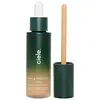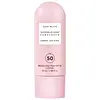ciele. Tint & Protect SPF 50+ Tinted Serum Versus Glow Recipe Watermelon Glow Niacinamide Sunscreen SPF 50
What's inside
What's inside
 Key Ingredients
Key Ingredients

 Benefits
Benefits

 Concerns
Concerns

 Ingredients Side-by-side
Ingredients Side-by-side

Zinc Oxide 12%
Cosmetic ColorantWater
Skin ConditioningC12-15 Alkyl Benzoate
AntimicrobialButyloctyl Salicylate
Skin ConditioningLauryl PEG-8 Dimethicone
Titanium Dioxide
Cosmetic ColorantCI 77891
Cosmetic ColorantIsododecane
EmollientPropanediol
SolventIron Oxides
CI 77492
Cosmetic ColorantDimethicone
EmollientNiacinamide
SmoothingPolymethylsilsesquioxane
Isohexadecane
EmollientTrilaureth-4 Phosphate
EmulsifyingDimethiconol
EmollientCaprylyl Methicone
Skin ConditioningMica
Cosmetic ColorantOctyldodecyl Neopentanoate
EmollientLauryl PEG-10 Tris(Trimethylsiloxy)Silylethyl Dimethicone
EmulsifyingSodium Chloride
MaskingPhenoxyethanol
PreservativeBisabolol
MaskingCI 77491
Cosmetic ColorantDisteardimonium Hectorite
StabilisingCI 77499
Cosmetic ColorantCaprylyl Glycol
EmollientAllantoin
Skin ConditioningPolyglyceryl-4 Diisostearate/Polyhydroxystearate/Sebacate
EmulsifyingAluminum Hydroxide
EmollientHydrogenated Lecithin
EmulsifyingEthylhexylglycerin
Skin ConditioningHexylene Glycol
EmulsifyingPropylene Carbonate
SolventPEG-10
HumectantZinc Oxide 12%, Water, C12-15 Alkyl Benzoate, Butyloctyl Salicylate, Lauryl PEG-8 Dimethicone, Titanium Dioxide, CI 77891, Isododecane, Propanediol, Iron Oxides, CI 77492, Dimethicone, Niacinamide, Polymethylsilsesquioxane, Isohexadecane, Trilaureth-4 Phosphate, Dimethiconol, Caprylyl Methicone, Mica, Octyldodecyl Neopentanoate, Lauryl PEG-10 Tris(Trimethylsiloxy)Silylethyl Dimethicone, Sodium Chloride, Phenoxyethanol, Bisabolol, CI 77491, Disteardimonium Hectorite, CI 77499, Caprylyl Glycol, Allantoin, Polyglyceryl-4 Diisostearate/Polyhydroxystearate/Sebacate, Aluminum Hydroxide, Hydrogenated Lecithin, Ethylhexylglycerin, Hexylene Glycol, Propylene Carbonate, PEG-10
Homosalate 8.5%
Skin ConditioningEthylhexyl Salicylate 5%
UV AbsorberOctocrylene 8.5%
UV AbsorberZinc Oxide 12.1%
Cosmetic ColorantWater
Skin ConditioningCaprylic/Capric Triglyceride
MaskingPropanediol
SolventGlycerin
HumectantCetearyl Olivate
Polyhydroxystearic Acid
EmulsifyingEthylhexyl Methoxycrylene
Skin ConditioningPotassium Cetyl Phosphate
EmulsifyingLauroyl Lysine
Skin ConditioningPhenyl Trimethicone
Skin ConditioningDimethicone
EmollientSorbitan Olivate
EmulsifyingInulin Lauryl Carbamate
Emulsion StabilisingXanthan Gum
EmulsifyingTriethoxycaprylylsilane
1,2-Hexanediol
Skin ConditioningCaprylyl Glycol
EmollientHydroxyacetophenone
AntioxidantPolyester-8
Skin ConditioningDiethylhexyl Syringylidenemalonate
Skin ProtectingCetearyl Alcohol
EmollientMenthone Glycerin Acetal
RefreshingLactic Acid
BufferingArachidyl Alcohol
EmollientChlorphenesin
AntimicrobialCitrullus Lanatus Fruit Extract
Skin ConditioningNiacinamide
SmoothingSodium Stearoyl Glutamate
CleansingCoco-Glucoside
CleansingBehenyl Alcohol
EmollientTrisodium Ethylenediamine Disuccinate
Aloe Barbadensis Leaf Juice
Skin ConditioningSilica
AbrasiveDimethicone Crosspolymer
Emulsion StabilisingArachidyl Glucoside
EmulsifyingSodium Citrate
BufferingParfum
MaskingSodium Hyaluronate
HumectantMagnesium Aspartate
Skin ConditioningZinc Gluconate
Skin ConditioningPhenoxyethanol
PreservativeCopper Gluconate
Skin ConditioningHomosalate 8.5%, Ethylhexyl Salicylate 5%, Octocrylene 8.5%, Zinc Oxide 12.1%, Water, Caprylic/Capric Triglyceride, Propanediol, Glycerin, Cetearyl Olivate, Polyhydroxystearic Acid, Ethylhexyl Methoxycrylene, Potassium Cetyl Phosphate, Lauroyl Lysine, Phenyl Trimethicone, Dimethicone, Sorbitan Olivate, Inulin Lauryl Carbamate, Xanthan Gum, Triethoxycaprylylsilane, 1,2-Hexanediol, Caprylyl Glycol, Hydroxyacetophenone, Polyester-8, Diethylhexyl Syringylidenemalonate, Cetearyl Alcohol, Menthone Glycerin Acetal, Lactic Acid, Arachidyl Alcohol, Chlorphenesin, Citrullus Lanatus Fruit Extract, Niacinamide, Sodium Stearoyl Glutamate, Coco-Glucoside, Behenyl Alcohol, Trisodium Ethylenediamine Disuccinate, Aloe Barbadensis Leaf Juice, Silica, Dimethicone Crosspolymer, Arachidyl Glucoside, Sodium Citrate, Parfum, Sodium Hyaluronate, Magnesium Aspartate, Zinc Gluconate, Phenoxyethanol, Copper Gluconate
 Reviews
Reviews

Ingredients Explained
These ingredients are found in both products.
Ingredients higher up in an ingredient list are typically present in a larger amount.
Caprylyl Glycol is a humectant and emollient, meaning it attracts and preserves moisture.
It is a common ingredient in many products, especially those designed to hydrate skin. The primary benefits are retaining moisture, skin softening, and promoting a healthy skin barrier.
Though Caprylyl Glycol is an alcohol derived from fatty acids, it is not the kind that can dry out skin.
This ingredient is also used as a preservative to extend the life of products. It has slight antimicrobial properties.
Learn more about Caprylyl GlycolDimethicone is a type of synthetic silicone created from natural materials such as quartz.
What it does:
Dimethicone comes in different viscosities:
Depending on the viscosity, dimethicone has different properties.
Ingredients lists don't always show which type is used, so we recommend reaching out to the brand if you have questions about the viscosity.
This ingredient is unlikely to cause irritation because it does not get absorbed into skin. However, people with silicone allergies should be careful about using this ingredient.
Note: Dimethicone may contribute to pilling. This is because it is not oil or water soluble, so pilling may occur when layered with products. When mixed with heavy oils in a formula, the outcome is also quite greasy.
Learn more about DimethiconeNiacinamide is a multitasking form of vitamin B3 that strengthens the skin barrier, reduces pores and dark spots, regulates oil, and improves signs of aging.
And the best part? It's gentle and well-tolerated by most skin types, including sensitive and reactive skin.
You might have heard of "niacin flush", or the reddening of skin that causes itchiness. Niacinamide has not been found to cause this.
In very rare cases, some individuals may not be able to tolerate niacinamide at all or experience an allergic reaction to it.
If you are experiencing flaking, irritation, and dryness with this ingredient, be sure to double check all your products as this ingredient can be found in all categories of skincare.
When incorporating niacinamide into your routine, look out for concentration amounts. Typically, 5% niacinamide provides benefits such as fading dark spots. However, if you have sensitive skin, it is better to begin with a smaller concentration.
When you apply niacinamide to your skin, your body converts it into nicotinamide adenine dinucleotide (NAD). NAD is an essential coenzyme that is already found in your cells as "fuel" and powers countless biological processes.
In your skin, NAD helps repair cell damage, produce new healthy cells, support collagen production, strengthen the skin barrier, and fight environmental stressors (like UV and pollution).
Our natural NAD levels start to decline with age, leading to slower skin repair, visible aging, and a weaker skin barrier. By providing your skin niacinamide, you're recharging your skin's NAD levels. This leads to stronger, healthier, and younger looking skin.
Another name for vitamin B3 is nicotinamide. This vitamin is water-soluble and our bodies don't store it. We obtain Vitamin B3 from either food or skincare. Meat, fish, wheat, yeast, and leafy greens contain vitamin B3.
The type of niacinamide used in skincare is synthetically created.
Learn more about NiacinamidePhenoxyethanol is a preservative that has germicide, antimicrobial, and aromatic properties. Studies show that phenoxyethanol can prevent microbial growth. By itself, it has a scent that is similar to that of a rose.
It's often used in formulations along with Caprylyl Glycol to preserve the shelf life of products.
Propanediol is an all-star ingredient. It softens, hydrates, and smooths the skin.
It’s often used to:
Propanediol is not likely to cause sensitivity and considered safe to use. It is derived from corn or petroleum with a clear color and no scent.
Learn more about PropanediolWater. It's the most common cosmetic ingredient of all. You'll usually see it at the top of ingredient lists, meaning that it makes up the largest part of the product.
So why is it so popular? Water most often acts as a solvent - this means that it helps dissolve other ingredients into the formulation.
You'll also recognize water as that liquid we all need to stay alive. If you see this, drink a glass of water. Stay hydrated!
Learn more about WaterZinc Oxide is a mineral broad-spectrum UV filter; it is the broadest UVA and UVB reflector approved by the FDA. It also has skin protectant and skin soothing properties.
Zinc oxide is one of the most effective broad-spectrum UV filters. It protects against UVB, UVAII, and UVAI. In comparison to its counterpart titanium dioxide, zinc oxide provides uniform and extended UVA protection.
Another great benefit? This ingredient is highly photostable so it won't degrade easily under sunlight.
A common myth is that mineral UV filters are widely believed to primarily reflect UV light.
However, modern research shows titanium dioxide absorbs UV radiation like chemical filters (~95% absorption & 5% reflection).
Zinc oxide has great skin soothing properties so you'll likely find this in sunscreens formulated for sensitive skin or babies/children. It is unlikely to cause "eye sting" like other sunscreen ingredients.
Regulatory agencies consider zinc oxide to be non-toxic and safe. It has also been shown to not penetrate the skin.
Unfortunately, this ingredient does leave a visible white cast. This is why mineral sunscreens are often less cosmetically elegant than chemical or hybrid ones.
In cosmetics, zinc oxide can be found in both non-nano and nano-sized forms. The nano version is used to reduce white cast and improve the texture of sunscreen formulas.
There are ongoing concerns surrounding nano-zinc oxide's impact on marine ecosystems and whether it can be absorbed into skin.
Regarding marine ecosystems and coral reefs, there is no conclusive evidence that any form of zinc oxide (or any other sunscreen ingredients) will cause harm. The science is still developing but many consumers are keeping a close eye on this issue.
Please note, many destinations have reef-safety sunscreen rules. For instance, the U.S. Virgin Islands advises all visitors to use non-nano mineral sunscreens.
There has also been some stir about whether micronized or nano zinc oxide has potential photoxicity and absorption through the skin/lungs.
An in-vitro (done in a test tube or petri dish) study demonstrated micronized zinc oxide to have potential phototoxicity. There's no need to fret; the EU Commission's Scientific Committee on Consumer Safety has stated, "The relevance of these findings needs to be clarified by appropriate investigations in vivo." Or in other words, further studies done on living organisms are needed to prove this.
Current research shows zinc oxide nanoparticles do not penetrate intact or sunburned skin. They either remain on the surface or in the outermost layer of dead skin (stratum corneum).
Zinc oxide is one of only two classified mineral UV filters with titanium dioxide being the other one.
Fun fact: Zinc has been used throughout history as an ingredient in paint and medicine. An Indian text from 500BC is believed to list zinc oxide as a salve for open wound. The Ancient Greek physician Dioscorides has also mentioned the use of zinc as an ointment in 1AD.
Learn more about Zinc Oxide